When you’re just getting into laser crafting, you may be overwhelmed with a bunch of new terminology. I break down the three common types of lasers: diode , CO2, and IR (infrared) lasers…so you can make the best choice for your needs, space and budget!


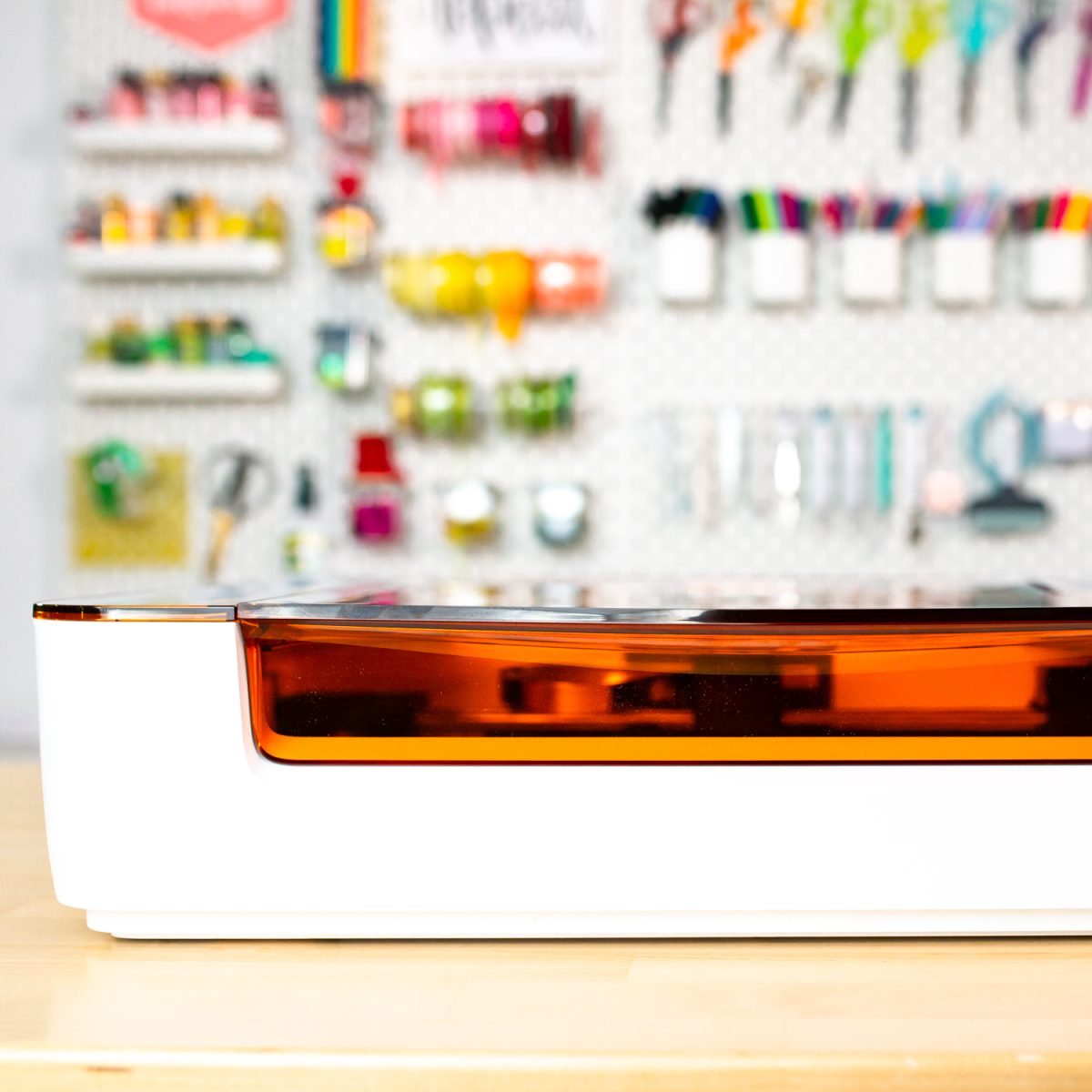
When I got my first laser a few years ago, I remember being completely overwhelmed by all of the specifications and terminology. It took me a long time to finally take the leap in purchasing my first laser because, frankly, it felt like a male-dominated tech space that wasn’t particularly welcome to everyday crafters (particularly women) at the time. Thankfully a lot of that has changed, but unfortunately there are a lot of folks out there who look down on new laser users.
That’s not me—I’m glad you’re here, no matter where you are on your journey!
In today’s post, I want to break down the three primary types of crafting lasers you might be looking at if you want to get into laser crafting in a language you can understand! I’ll try and avoid a ton of jargon so that you can understand what you’re actually looking at when it comes to buying a laser. I won’t go deep into the technical specifications, but I’ll show you what you can actually do with each type.
There are pros and cons to each type of laser (there’s no “best” option), so you’ll have to make the best choice for your needs, space, and budget.
Laser Comparison
To see a comparison of all of my lasers, check out my guide below! This is a detailed comparison of all of the lasers I’ve reviewed here on my blog, along with specs, special features, links to my reviews, and more.
Watch the Video
Want to get a video overview of these different types of lasers? Just hit play below! Or keep reading for a written explanation.
Diode Lasers
A diode laser uses a semiconductor to create the laser. How? I’m not sure, but it’s science. Then multiple diode laser beams are combined using mirrors inside the laser head, combining them into a single beam can cut and engrave materials.
What you really need to know is that a diode laser is a more economical laser, making them perfect for beginners and those with a smaller budget. They also tend to be smaller overall and much lighter (I can pick up and move all of my diode lasers on my own).
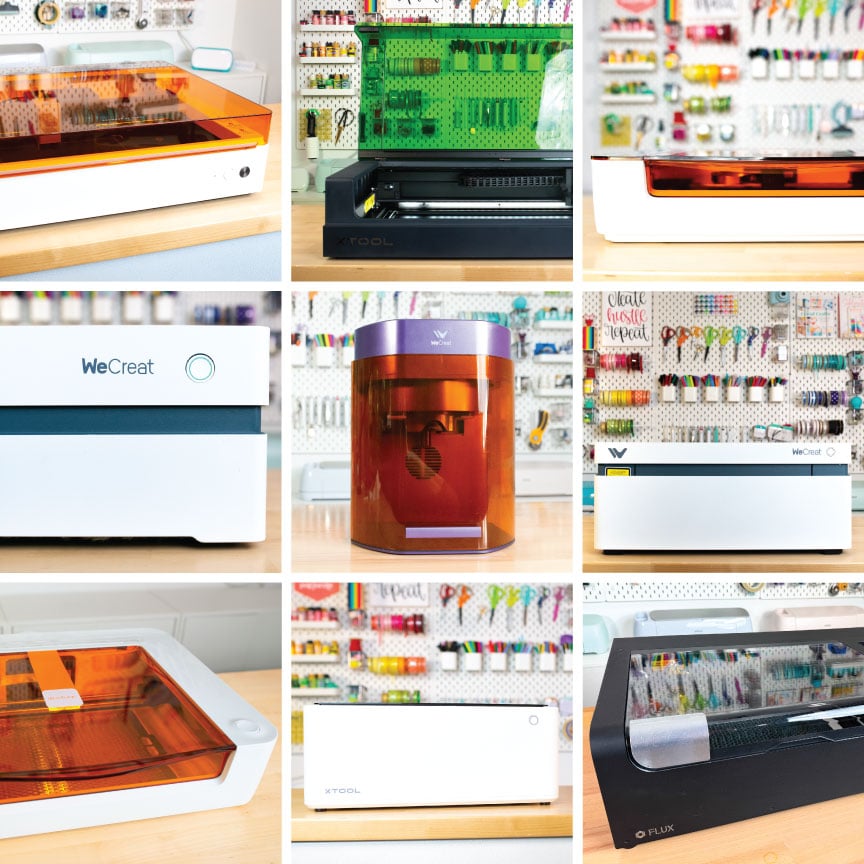
I have used and reviewed eight diode lasers, from top to bottom, left to right: xTool M1 Ultra, xTool S1, Glowforge Aura, WeCreat Vista, WeCreat Lumos, WeCreate Vision, Glowforge Spark, and xTool M1. The final laser is the FLUX beamo, which is primarily a CO2 laser, but it does have a swappable diode laser head.
Diode lasers are also more durable than CO2 lasers and can have a longer lifespan. When talking about diode lasers, the output power is generally from 10W to 20W, but there are some that go up to 40W and above.
The bit thing with diode lasers is that laser beam is on the blue spectrum, making it impossible to cut blue, clear, and a few other colors of acrylic (it just goes right through), though it can work on darker opaque acrylics. Diode lasers work great on wood, leather, and other natural materials.
If you want to cut and engrave clear, blue, and other translucent acrylic, you’ll want to get a CO2 laser instead.
Diode lasers also cannot engrave metal well unless it has a coating. You can engrave powder coated blanks (like tumblers), or you can use a special coating (which tends to be a bit expensive) on uncoated metals. If you want to engrave uncoated metal with no special coating, you’ll want to look at IR lasers.
Some diode lasers do not come with their own enclosure and I see people using them without any safety precautions which is, frankly, terrifying. Instead, I highly recommend getting a diode laser with a safety enclosure, like all eight diode lasers I show above.
CO2 Lasers
Inside a CO2 laser is a glass tube with a whole bunch of gasses inside (including CO2 at the highest proportion—that’s where this laser type gets its name). These gasses interact with each other using, again, science, and some of those gasses emit an intense energy in the form of light. This light is focused to create the laser beam.

I have and have used three CO2 lasers, the FLUX beamo, the xTool P2S, and the Glowforge Pro.
A CO2 laser can be very powerful and falls on the infrared spectrum, but at a different part of the spectrum than an IR laser below. This allows it to cut through more materials than the diode laser, including all colors of acrylic. I have found that my particular CO2 laser is faster than my diode lasers as well, so if time is important to you, you’ll probably want a CO2 laser.
CO2 lasers tend to be larger and heavier. I cannot pick up and move my larger CO2 lasers without help, though I can manage my FLUX beamo. You’ll probably be looking at CO2 lasers with output power between 30W and 300W, probably on the lower end for a more affordable laser.
CO2 lasers require more maintenance and cleaning than diode lasers and they wear out faster. Some large-volume users say they are replacing their lasers every few years. I have not had to replace any of my CO2 lasers yet.
CO2 lasers cannot engrave metal well unless it has a special coating (which tends to be a bit expensive). If you want to engrave metal, a fiber laser is a much better option.
Like diode lasers, CO2 lasers cannot engrave metal well unless it has a coating. You can engrave powder coated blanks (like tumblers), or you can use a special coating (which tends to be a bit expensive) on uncoated metals. If you want to engrave uncoated metal with no special coating, you’ll want to look at IR lasers.
IR Lasers
If you’ve been wanting to engrave on uncoated metal—like stainless steel tumblers, aluminum cards, or jewelry blanks—you might want to check out an IR laser. IR is shorthand for infrared. These lasers usually come in 2W or 3W versions and are designed to do something that most other craft lasers can’t: engrave on uncoated metal, without needing special sprays or coatings. They do tend to be more expensive, though the price is coming down.
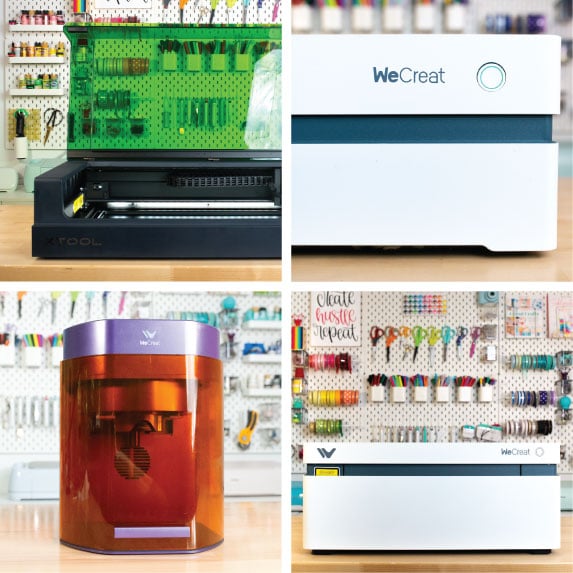
I have four IR lasers. Note that all of these lasers are also diode lasers! For the xTool S1, WeCreat Vista, and WeCreat Vision, the laser module is swappable. So you’ll pull out the diode laser head and swap in the IR laser head. For the WeCreat Lumos, both laser heads are built in and there is no swapping.
So how does an IR laser work? Without getting too technical, the laser creates a beam of infrared light that is on a different part of the infrared spectrum than the CO2 laser above. This light is absorbed by metal in a way that lets it mark the surface directly, creating crisp, permanent engravings. Just keep in mind that IR lasers really are for engraving only—they don’t cut materials like wood or acrylic.
Which Laser Type is Best?
Like I said above, there’s no “best” when it comes to lasers. You’ll need to think about your needs, your space, and your budget. Definitely read reviews of each laser and keep what you learned in this post in mind.
Diode lasers: economical, easy to use, lasts a long time, cuts and engraves natural materials and coated metal (engrave only), struggles with acrylic, cannot engrave uncoated metal.
CO2 lasers: more expensive, a bit of a learning curve, less durable, cuts and engraves natural materials, coated metal (engrave only), and all colors of acrylic, cannot engrave uncoated metal.
IR lasers: more expensive, easy to use, very fast, engraves uncoated metal and a few other materials. Cannot cut. Cannot engrave most other materials.
I hope you found this overview of different laser types helpful! Let me know in the comments if you’re looking at a diode, CO2, or IR laser. I’d love to hear what you want to make!
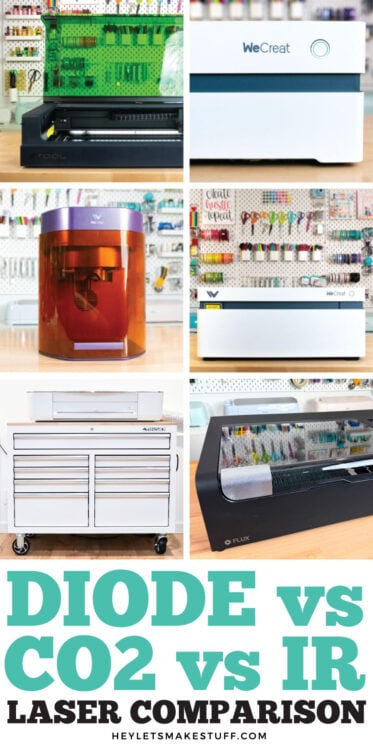
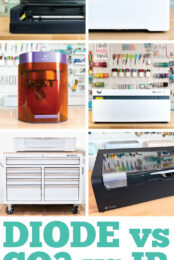


Leave A Reply!